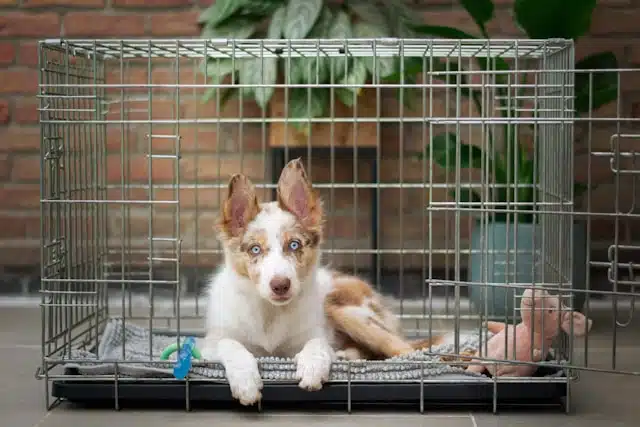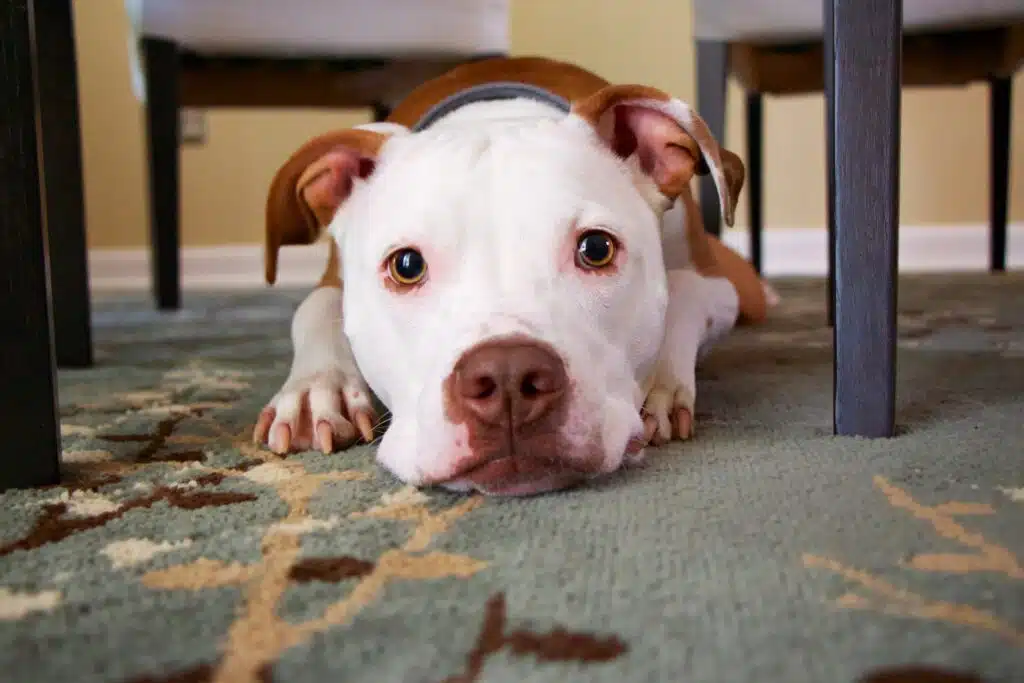Home » Blog » Pet » Pet Health & Safety » 7 Benefits of Not Crate Training a Puppy
Categories
Tags
animal welfare
breed profile
buying a car
buying a pet
Car
car accessories
car care
car features
car insurance
Car safety
car sales
car service
cat
cat behaviour
cat body language
Cat Breeds
cat food
cat insurance
comprehensive car insurance
Dog
Dog Behaviour
dog body language
Dog Breeds
dog food
Dog Insurance
dog training
eco friendly cars
Kitten
New Car
pet accessories
pet activities
Pet Adoption
pet breeders
pet days of the year
pet fun stuff
Pet Health
pet insurance
pet parenting
Pet Safety
pet services
Puppy
rescue pets
road safety
road trip
safe driving
Recent Blog:
Facebook Posts
1 week ago
Ready for a fun challenge? 🐾 Take a wild guess: What breed is this adorable fellow? 🐶 Drop your answers in the comments, and don't forget to scroll down to check if you nailed it! 🎯 Let's see who knows their dog bree#dogbreedquizgBreedQuiz![]() .
.![]() .
.![]() .
.![]() .
.![]() .
.![]() .
.![]() .
.![]() .
.![]() .
.![]() .
.![]() .
.![]() .
.![]() .
.![]() .
.![]() .
.![]() Lagotto Romagnolo
... See MoreSee Less
Lagotto Romagnolo
... See MoreSee Less
1 week ago
Did you know heart disease in dogs and cats can start with bad oral health? Find out more.....
... See MoreSee Less
Why Pet Dental Health is Linked to Heart Disease and Other Illness
bit.ly
Pet dental health usually brings to mind images of teeth and gums. In reality, it goes far beyond that. Pet oral health can be directly linked to systemic2 weeks ago
Yes or No - got any road adventures planned for Easter? Whatever you answered, here are some great ideas for this year (or next):![]() #easter.
... See MoreSee Less
#easter.
... See MoreSee Less
Driving, Flying and Staycations with Dogs and Cats this Easter
bit.ly
Is cat or dog friendly Easter travel on your wishlist? You're one of many! Travelling with dogs, cats and even some other critters (think bearded dragonsFor some dogs and pet parents, the benefits of not crate training outweigh the pros. In part one of this series, we looked at reasons you might choose crate training for a dog. In this article, which is part two, we’re looking at reasons to not crate train a dog.
There’s no one size fits all when it comes to dogs. While plenty of puppies and dogs love their crates, whether at home or as a safe space during travels, it’s not every dog’s cup of tea. For this reason, we’ve outlined several reasons when other options might be more suitable for pets and their humans.
In this article
- Crate training pros – visit these links instead
- Onto the benefits of not crate training a puppy
- Con #1: Puppy was bred by a backyard breeder
- Con #2: They come from a disreputable pet shop
- Con #3: As a rescue dog they’ve suffered trauma
- Con #4: Crates are not babysitters
- Con #5: Your dog has separation anxiety
- Con #6: Vomiting or diarrhoea is involved
- Con #7: Crate training does not benefit your pet parenting style
- When to call on a pet behaviourist to crate train
- Award winning pet insurance for a soft landing

Crate training pros – visit these links instead
In part one of this series, we covered off lots of potential wins that come from crate training a puppy. (Pssst, since we’re talking about what’s good for puppies, be sure to check out puppy insurance to help pay for unexpected vet bills). These included aspects of daily doggy life, such as toilet training, vet visits, travelling with pets, downtime and more.
We also covered off what crate training puppies involves and how long is the right amount of time to be in a crate based on their age and development. If you’re keen on knowing the pros, then read all about the benefits of crate training a puppy.
Onto the benefits of not crate training a puppy
They say every dog has its day and the same can be said of every dog having its personal needs too. To each their own what dogs need often come down to their life experiences.
For example, a puppy that is found on the roadside or an older dog getting its second chance as an adopted dog could have trauma that makes crate training seem like a big red flag to them.
That said, you can teach an old dog new tricks so if enough time and attention is given, even a dog with trauma may be able to one day enjoy the comfort that a crate provides many canine companions.
If you’re unsure, have a read through the pros then read these reasons to not crate train a dog or puppy…

Con #1: Puppy was bred by a backyard breeder
Puppies that are born and bred in puppy mills (also called puppy farms) are often born into poor conditions. Dog breeding mills work to produce litters for profit alone so mum and pups may be kept in small cages with no exercise, playtime or socialisation.
Crate training puppies from mills can add to their trauma because small cages are associated with stress for them.
In addition, the hygiene and overall health of these dogs is often overlooked. No health testing is done on breeding dogs and dogs that are pregnant aren’t provided with the right food to grow healthy puppies.
New puppy owners may unwittingly purchase from a breeding mill if they don’t take the steps to find an ethical dog breeder.

Con #2: They come from a disreputable pet shop
Like dog breeders, pet shops come in all stripes. If you’re buying from a pet shop, aim to buy from an ethical pet store rather than one that overlooks the animals’ welfare.
- Ethical pet stores
Well-run, ethical pet stores put their best paw forward by taking a health lens on how puppies are kept. Ethical pet shops have decent sized enclosures for puppies to move about and play in.
They won’t cram too many puppies into a single enclosure and may limit the number to only a few. Puppies will also have time to access open play areas for playtime and running so they can healthily spend their zoomies.
- Unethical pet stores
On the other hand, you do still get pet shops that cram puppies into tiny enclosures without the chance to explore, run, sniff or play.
Puppies that have been confined for long periods in their early weeks don’t get any downtime or quiet isolated corners to retreat to.
For these puppies, crate training can evoke all sorts of bad memories and rather than being a den, will seem like confinement. If you’re buying a puppy at a pet store, be aware of this and try to support those with best practices for pet health.
Also consider bringing home your pooch with the safety net of a dog insurance plan for those unforeseen vet bills.

Con #3: As a rescue dog they’ve suffered trauma
Rescue dogs come with a wide array of histories and quite often trauma. Like us, dogs do retain the memories of their past traumatic experiences and need to be coached and helped to overcome these.
For many dogs, having a crate is a safe space to enjoy downtime in – their kingdom that is theirs and theirs alone. However, a traumatised dog who’s been confined to a cage without the option to move about freely is less likely to be able to enjoy crate time.
Who knows if your rescue dog was confined as a form of punishment? Or maybe neglected by being locked up for days? If so, a crate can act as a barrier that prevents your dog from bonding with and feeling close to and protected by you.

Con #4: Crates are not babysitters
Never under any circumstances can a dog be left in a crate while you’re away all day at work. A crate is for short periods only and needs to contrast with other living areas and activities. Your dog must willingly go in and stay in their crate or it’s not being utilised properly.
Never confine your dog to a crate because you can’t pay them attention. Look for alternatives like pet sharing instead.
Crate training must never replace physical activities either. As pet parents, it’s imperative to not underestimate the importance of playtime for dogs. Spending too much time in a crate can cause dogs to become anxious and it can atrophy their muscles. Find out how long is too long further down…

Con #5: Your dog has separation anxiety
If a dog has separation anxiety or isolation distress then crate training won’t benefit them. On the contrary, it may foment deeper levels of fear. Not every dog needs or suits crate training, so listen to your dog’s needs and follow your gut.
- Choosing the right pet for your lifestyle
Separation anxiety in pets can be tackled a number of ways. Firstly, before you choose a pet, consider whether you should get a dog if you work fulltime. Then, if you decide a canine companion is the option to fill your heart, do some research to get a breed that matches your home and lifestyle.
- Ways to keep your puppy socialised while you’re away
Following on from this, explore doggy daycare, pet sharing and kennels and pet sitters. You never know, maybe a neighbour or friend would enjoy keeping your dog company part time for a few days a week. It’s important not to leave dogs alone at home for longer than is good for them.

Con #6: Vomiting or diarrhoea is involved
Crate trained dogs need to be out of the crate when they’re vomiting or have diarrhoea. If they soil their cage, it’s the equivalent of you or I doing the same said activities in our beds – eek!
Even after you change the crate bedding your dog’s association toward their crate may change. A negative association with the crate means they lose their den, which neither you nor they will want.
You also should never leave your puppy or dog inside a crate for too long even when they’re healthy. They could end up soiling it, which will further any associations with entrapment and unhealthy isolation.
Here’s more on dog vomiting and identifying gastro.
Con #7: Crate training does not benefit your pet parenting style
Every pet parent has their own parenting style, just like human parents. While your neighbour might crate train their puppy, you might naturally gravitate towards the benefits of not crate training.
As a dog mum or dad, bonding and building your relationship with pooch the way that suits you is always important. Here are some great pet parenting reads you might enjoy:
- What’s your pet parenting style?
- Pet parents have their say on Love Your Pet Day
- 7 Steps to being the purrfect pet parent
- Pet technology for the modern pet parent
Now, let’s take a quick look at what to do if you’d like to crate train your puppy, but they’re finding it too scary.

When to call on a pet behaviourist to crate train
Many people feel crate training a puppy is cruel. But take heart in the fact that even when there’s no nearby crate dogs tend to curl up under or behind things like tables, beds, and blankets. That’s because they have a natural penchant for denning behaviour.
- Denning behaviour. Denning behaviour is an innate behaviour that helps dogs feel stable because the enclosed, quiet space is a relief for their senses.
- Reasons to not crate train a dog. However, as we’ve explored, you or your dog may have adverse feelings toward a crate. For instance, you perceive the crate as a cage in which case your dog is also likely to form the same associations. Remember, they’re very perceptive of our emotions.
- Unlearning the fear and experiencing the crate training benefits. If your dog has negative associations with enclosed spaces like crates, you might still like need them to go in crates on occasion. For example, when travelling and for vet visits. A pet behaviourist can help dogs unlearn behaviours associated with trauma and relearn the correct associations.
Award winning pet insurance for a soft landing
Now that you know the benefits of not crate training, along with the rewards in part one, here’s another consideration for your pet’s wellbeing: pet insurance.
If your dog is misbehaving and you’re not sure why, they might be sick or injured. Dog insurance helps reduce your pet’s medical costs across their lifetime. It can help cover the vet costs associated with accidents, illness, third party liability, medication, non-routine vet visits and more. Depending on the level of cover you choose, you can even get pet dental cover.
When you choose award winning cover with PD Insurance, we’ll give you one or more months of pet insurance FREE! Click below to get a quote for your daring dog or curious cat.
Share On:



